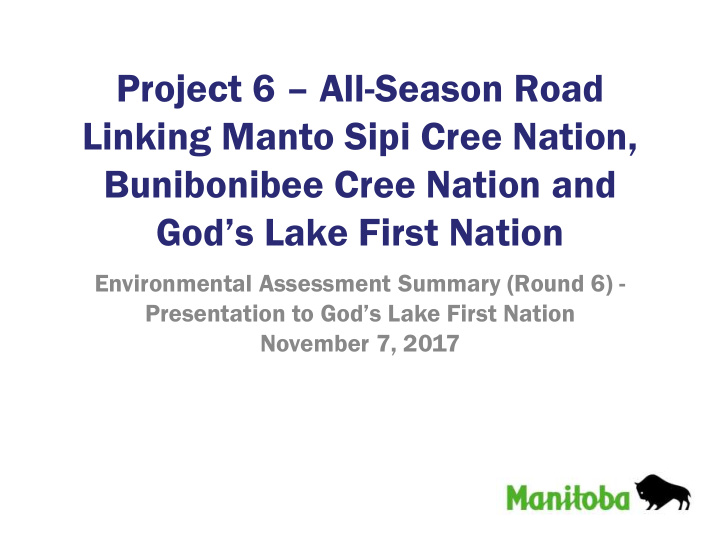



Project 6 – All-Season Road Linking Manto Sipi Cree Nation, Bunibonibee Cree Nation and God’s Lake First Nation Environmental Assessment Summary (Round 6) - Presentation to God’s Lake First Nation November 7, 2017
Why are we here? – Provide information about the proposed P6 All-Season Road Project – Discuss the previous meetings – Summarize potential effects and mitigation measures – Hear from you about what you value, so that it can be considered in the Environmental Assessment (EA) and addressed in the project design
Project P6 – All-Season Road
Project P6 – All-Season Road
Description of Project P6 • 138.3 km ASR linking Manto Sipi, Bunibonibee and God’s Lake: – 66.4 km section joining Bunibonibee and God’s Lake – 71.9 km section from Manto Sipi intersecting the above • Includes two major water crossings: – God’s River – Magill Creek • Approximately 51 minor crossings or drainage equalization culverts
Major Water Crossings God’s River Magill Creek
Prior Community Discussions • Since 2009, meetings have been held with God’s Lake to discuss the project and select the best road location (Previous to the EA) – Community Meetings • January 6, 2016 • November 4, 2014 • June 9, 2010 • April 17, 2009 – Meetings with Chief and Council • October 25, 2016 • July 15, 2014 • May 10, 2010
Prior Community Discussions – Traditional Knowledge (TK) Studies, Workshops and Interviews • January 6 and March 22, 2016 • November 19 - 26, 2015 • October 6, 2015 • April 17, 2009 • Past discussions resulted in changes to the potential route to avoid sensitive areas based on community input • Specifically for the EA meetings were held on December 9, 2016 (Round 4) and March 24, 2017 (Round 5)
Round 4 Meeting • Was held on December 9, 2016 • The purpose of the meeting was to: – Provide an overview of the project – Inform the community of the overall Environmental Assessment (EA) process – Discuss how the proposed road alignment has evolved based on feedback to avoid community sensitive areas – Dialogue with the community about which Valued Components should be the focus of the EA process
Summary of What We Heard – Round 4 Meeting • What we heard from you: – Interest in how the Traditional Knowledge collected will be used now that the East Side Road Authority has been absorbed by Manitoba Infrastructure – Interest in recent alignment changes and whether additional studies or tree clearing will need to be conducted or if the assessment process delayed – Interest in when borrow pit locations will be determined, what types of materials will be used and whether there will be blasting – Interest in road construction contracts – Youth should be encouraged and specifically invited to attend the meetings – Magill Creek is also named Young Lady Creek and is important for fishing and hunting – Geese, moose and caribou are hunted most – Ice/snow conditions in the spring make it dangerous to be on the land – Interested in the health of water and fish
Round 5 Meeting • Was held on March 24, 2017 • The purpose of the meeting was to: – Provide an overview of the project – Discuss Round 4 meeting – Discuss potential effects and possible mitigation measures – Hear from the community about what you value, so that it can be considered in the Environmental Assessment and addressed in the Project design
Summary of What We Heard – Round 5 Meeting • What we heard from you: – Moose population appears to be declining in the area possibly because of tree clearing – The road will not affect animals as they will return when construction is completed and the road may also attract animals – Manitoba Infrastructure should involve youth in the community for project input and what to expect in the future – An elder indicated a section of the road crosses through his trapline and wanted to know how this would impact his trapline and suggested changing the alignment – A former Chief and Councillor stated he was not concerned how the road will affect wildlife, heritage resources or the general environment but rather how it will affect the community • alcohol and drugs come into the community • businesses that use community resources without providing economic benefit
What Is Environmental Assessment
Baseline Data • Traditional Knowledge (TK) • Baseline studies to augment TK studies – Vegetation – Wildlife – Archaeology/Heritage – Fish and Habitat • Used to confirm alignment • Provide information for the Environmental Assessment • Used to assist in project design and construction
Inputs Into The EA Process
How to Address Possible Effects Mitigation measures are actions that can be done to avoid or reduce the effects that a project may have on the environment
Potential Effects Moose and Caribou
Potential Effects Furbearers
Potential Effects Birds
Potential Effects Vegetation
Potential Effects Fish, Reptiles and Amphibians
Potential Effects Heritage and Cultural Sites
Potential Effects Traditional Resource Activities
Schedule
Table Talks! Please stay and talk with us! • We want to hear and learn from you! • Write on the boards • Tell us what is important to you, and what should be considered • Please complete a comment sheet Moose Next Steps: • Finalize the Environmental Impact Statement and submit to federal and provincial regulators by early 2018 • On-going communication and dialogue with the communities Caribou
Thank you for your participation Contact Information: Phone 1-204-945-3660 Fax 1-204-945-0593
Recommend
More recommend